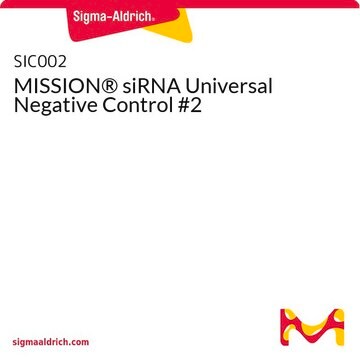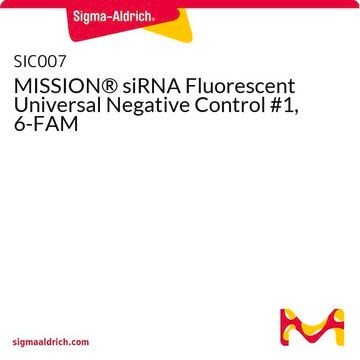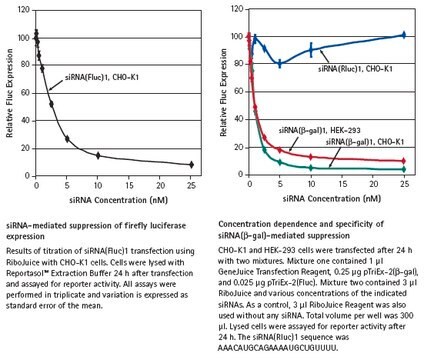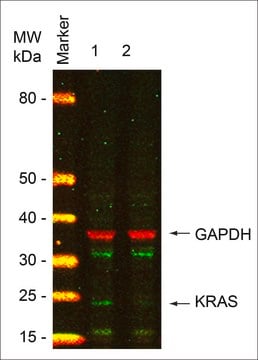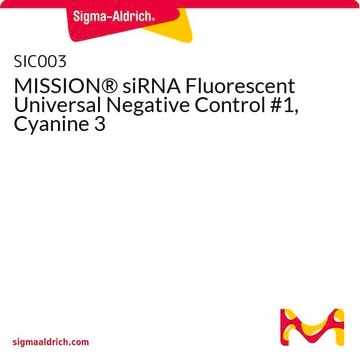S1452
MISSION® siRNA Transfection Reagent
Synonym(s):
MISSION® siRNA Transfection Reagent
Sign Into View Organizational & Contract Pricing
All Photos(1)
About This Item
UNSPSC Code:
41106502
NACRES:
NA.51
Recommended Products
product line
MISSION®
form
aqueous solution
shipped in
wet ice
storage temp.
2-8°C
General description
The MISSION® siRNA Transfection Reagent is for the transfection of siRNA to achieve ≥90% silencing efficiency for transient knockdown of eukaryotic gene expression.
Effective gene silencing and reduced off target effects are achieved using a low siRNA concentration (1nM). The siRNA Transfection Reagent is provided as a sterile solution, and is compatible with serum and antibiotics.
Effective gene silencing and reduced off target effects are achieved using a low siRNA concentration (1nM). The siRNA Transfection Reagent is provided as a sterile solution, and is compatible with serum and antibiotics.
Other Notes
Gene silencing assay: An A549 cell line stably expressing firefly luciferase was transfected in 24-well plates with 8.4 ng of 21-mer Luciferase siRNA using 2 μL of the MISSION® siRNA Transfection Reagent. Experiments were performed in triplicate in presence of serum. Cell lysates were assessed for luciferase expression 48 hours post-transfection.
Legal Information
MISSION is a registered trademark of Merck KGaA, Darmstadt, Germany
related product
Product No.
Description
Pricing
Signal Word
Warning
Hazard Statements
Precautionary Statements
Hazard Classifications
Flam. Liq. 3
Storage Class Code
3 - Flammable liquids
WGK
WGK 3
Flash Point(F)
120.2 °F
Flash Point(C)
49 °C
Certificates of Analysis (COA)
Search for Certificates of Analysis (COA) by entering the products Lot/Batch Number. Lot and Batch Numbers can be found on a product’s label following the words ‘Lot’ or ‘Batch’.
Already Own This Product?
Find documentation for the products that you have recently purchased in the Document Library.
Customers Also Viewed
Ilaria Guerriero et al.
Oncotarget, 8(12), 19172-19191 (2016-11-24)
Hyperactivation of the PI3K/AKT pathway is observed in most human cancer including lung carcinomas. Here we have investigated the role of miRNAs as downstream targets of activated PI3K/AKT signaling in Non Small Cell Lung Cancer (NSCLC). To this aim, miRNA
Tuyen T Dang et al.
Cancers, 12(7) (2020-07-11)
It was recently shown that the 5' to 3' exoribonuclease XRN2 is involved in the DNA damage response. Importantly, loss of XRN2 abrogates DNA double stranded break repair via the non-homologous end-joining pathway. However, the mechanistic details of how XRN2
Tuyen T Dang et al.
International journal of molecular sciences, 21(12) (2020-06-19)
Cellular survival is dependent on the efficient replication and transmission of genomic information. DNA damage can be introduced into the genome by several different methods, one being the act of DNA replication. Replication is a potent source of DNA damage
A E Witt et al.
Oncogene, 36(12), 1707-1720 (2016-10-04)
Tumours are comprised of a highly heterogeneous population of cells, of which only a small subset of stem-like cells possess the ability to regenerate tumours in vivo. These cancer stem cells (CSCs) represent a significant clinical challenge as they are
Jose Miguel Escandell et al.
The EMBO journal, 38(7) (2019-02-24)
Telomeres, the protective ends of eukaryotic chromosomes, are replicated through concerted actions of conventional DNA polymerases and elongated by telomerase, but the regulation of this process is not fully understood. Telomere replication requires (Ctc1/Cdc13)-Stn1-Ten1, a telomeric ssDNA-binding complex homologous to
Our team of scientists has experience in all areas of research including Life Science, Material Science, Chemical Synthesis, Chromatography, Analytical and many others.
Contact Technical Service



